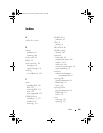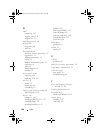
214 Glossary
refresh rate — The frequency, measured in Hz, at which your screen's horizontal lines
are recharged (sometimes also referred to as its vertical frequency). The higher the
refresh rate, the less video flicker can be seen by the human eye.
resolution — The sharpness and clarity of an image produced by a printer or displayed
on a monitor. The higher the resolution, the sharper the image.
RFI — radio frequency interference — Interference that is generated at typical radio
frequencies, in the range of 10 kHz to 100,000 MHz. Radio frequencies are at the
lower end of the electromagnetic frequency spectrum and are more likely to have
interference than the higher frequency radiations, such as infrared and light.
ROM — read-only memory — Memory that stores data and programs that cannot be
deleted or written to by the computer. ROM, unlike RAM, retains its contents after
you shut down your computer. Some programs essential to the operation of your
computer reside in ROM.
RPM — revolutions per minute — The number of rotations that occur per minute.
Hard drive speed is often measured in rpm.
RTC — real time clock — Battery-powered clock on the system board that keeps the
date and time after you shut down the computer.
RTCRST — real-time clock reset — A jumper on the system board of some computers
that can often be used for troubleshooting problems.
S
SAS — serial attached SCSI — A faster, serial version of the SCSI interface (as
opposed to the original SCSI parallel architecture).
SATA — serial ATA — A faster, serial version of the ATA (IDE) interface.
ScanDisk — A Microsoft utility that checks files, folders, and the hard disk’s surface
for errors. ScanDisk often runs when you restart the computer after it has stopped
responding.
SCSI — small computer system interface — A high-speed interface used to connect
devices to a computer, such as hard drives, CD drives, printers, and scanners. The
SCSI can connect many devices using a single controller. Each device is accessed by an
individual identification number on the SCSI controller bus.
SDRAM — synchronous dynamic random-access memory — A type of DRAM that is
synchronized with the optimal clock speed of the processor.
serial connector — An I/O port often used to connect devices such as a handheld
digital device or digital camera to your computer.
book.book Page 214 Monday, October 6, 2008 11:28 AM


















